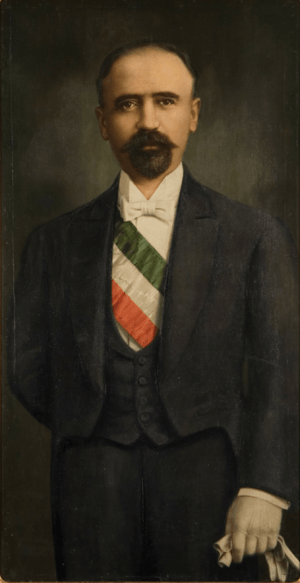Progressive Constitutionalist Party (Mexico) facts for kids
Quick facts for kids
Progressive Constitutionalist Party
Partido Constitucional Progresista
|
|
|---|---|
| Leaders | Francisco I. Madero, José María Pino Suárez, Juan Sánchez Azcona |
| Founder | Francisco I. Madero |
| Founded | 1909 (as the National Anti-Reelectionist Party) |
| Dissolved | 1913 |
| Headquarters | Mexico City |
| Ideology | Maderism Liberalism Constitutionalism Secularism |
| Political position | Centre |
| Colors | |
The Progressive Constitutionalist Party (Spanish: Partido Constitucional Progresista), often called the PCP, was a political group in Mexico. It was active from 1909 to 1913. This party believed in liberal ideas, which focus on individual rights and freedoms. It aimed to find a middle ground in Mexican politics.
The PCP was first started in 1909. Back then, it was known as the National Anti-Reelectionist Party. In 1911, it changed its name to the Progressive Constitutionalist Party.
What Did the Party Believe In?
The main idea of the Progressive Constitutionalist Party was constitutionalism. This means they wanted to make sure the country's main law, the Federal Constitution of 1857, was followed. They wanted to bring back fair laws after General Porfirio Díaz had ruled Mexico like a dictator for 30 years.
The PCP also believed in progress. They wanted to make some changes to help people. They hoped these changes would make the country fairer. This was important because Mexico was on the edge of a big social uprising, known as the Mexican Revolution. The party's ideas came from a popular book. It was called The Presidential Succession in 1910. Francisco I. Madero, who came from a very rich family, wrote this book in 1909.
A Brief History of the PCP

In 1911, Francisco I. Madero won the election to become President of Mexico. José María Pino Suárez became the Vice President. After their victory, the PCP was in charge of Mexico from 1911 to 1913. During this time, many PCP members also won local elections.
From 1912 to 1913, the PCP had the most members in the Mexican Congress. But in February 1913, a military takeover happened. This event is known as the Ten Tragic Days. The military removed Madero's government. This stopped the country from following the 1857 Constitution. The PCP did not come back together after this. However, many former members later helped shape Mexico after the Mexican Revolution.
Like an older party before it, the PCP also split into different groups. Some members felt that Madero's leadership was too traditional. They thought the party was not doing enough for the social changes the Revolution wanted. So, they started a new group called the Liberal Constitutionalist Party (PLC). This new party, led by Venustiano Carranza, aimed for more social changes.
Later, in 1929, the PLC joined to form the National Revolutionary Party (PNR). This party ruled Mexico for a very long time, from 1929 to 2000. Another group, led by José Vasconcelos, felt the PNR had become too controlling. They thought it had forgotten the liberal ideas of Madero and the PCP.
In the 1929 presidential election, which many believed was unfair, José Vasconcelos briefly brought back the National Anti-Reelectionist Party. He ran for president against the government's candidate. Years later, one of Vasconcelos's helpers, Manuel Gómez Morín, started the National Action Party (PAN). This party became the main opposition to the PNR.
In 2000, Vicente Fox from the PAN won the presidential election. He became the first president from an opposition party since the Revolution. This showed that Mexico had finally achieved the democratic changes Madero had hoped for.
See also
 In Spanish: Partido Constitucional Progresista para niños
In Spanish: Partido Constitucional Progresista para niños

